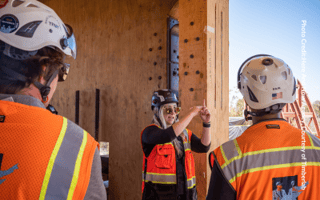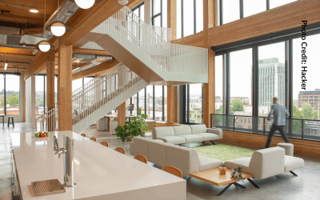The next generation of architects and engineers will help transition the industry to...
How Exactly Does Building With Wood Affect Climate Change?
Building with lumber, mass timber, and other wood products has gained attention as a method in addressing climate change. But for those beginning to learn about wood as a building material, the connection between wood and climate change isn’t obvious. If trees are one of the best ways to remove carbon dioxide from the air, why would we want to harvest more of them?
The answer comes from a concept called stored (or sequestered) carbon. As trees absorb carbon dioxide from the atmosphere, the carbon remains locked in the wood as cellulose if the tree is harvested for production – as opposed to decaying on the forest floor and releasing the carbon back to the air. Wood buildings essentially act as large carbon sinks that withhold carbon from the atmosphere for the life of the building—a unique environmental attribute that other structural materials like steel and concrete don’t have.
Stored carbon is a different but related concept to embodied carbon, which refers to the carbon emissions generated from the manufacturing, transportation, installation, maintenance, and disposal of buildings and component materials. With the least embodied carbon of all major building materials such as metals, concrete, or bricks, wood products have lower embodied carbon – and therefore contribute to the reduction of a building’s total carbon footprint.
Using wood to reduce the built environment’s carbon emissions is one of the strategies discussed in the CEU “Architecting Change: Design Strategies for a Healthy, Resilient, Climate Smart Future.” The course examines a paper in the journal Nature Sustainability that analyzes how much carbon could be stored by wood buildings. Depending on how many new buildings are constructed with wood over the next 30 years, the answer could range from 10 million tons of carbon stored per year to nearly 700 million tons.
Standing trees, well managed forests, and wood products are all critical aspects of supporting a sustainable supply chain of natural building materials. Increasing demand for wood products improves incentives for private forest owners to preserve and manage their lands for long-term health and productivity. By growing our forest lands to sequester carbon and producing materials that store them away, building with wood is a positive step that design and construction professionals can take to mitigate climate change.


